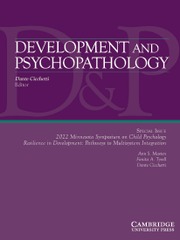Crossref Citations
This article has been cited by the following publications. This list is generated based on data provided by
Crossref.
Stefanatos, Gerry A.
2008.
Regression in Autistic Spectrum Disorders.
Neuropsychology Review,
Vol. 18,
Issue. 4,
p.
305.
Waterhouse, Lynn
2008.
Autism Overflows: Increasing Prevalence and Proliferating Theories.
Neuropsychology Review,
Vol. 18,
Issue. 4,
p.
273.
Helt, Molly
Kelley, Elizabeth
Kinsbourne, Marcel
Pandey, Juhi
Boorstein, Hilary
Herbert, Martha
and
Fein, Deborah
2008.
Can Children with Autism Recover? If So, How?.
Neuropsychology Review,
Vol. 18,
Issue. 4,
p.
339.
Beauchaine, Theodore P.
Neuhaus, Emily
Brenner, Sharon L.
and
Gatzke-Kopp, Lisa
2008.
Ten good reasons to consider biological processes in prevention and intervention research.
Development and Psychopathology,
Vol. 20,
Issue. 3,
p.
745.
Morris, Edward K.
2009.
A case study in the misrepresentation of applied behavior analysis in autism: The gernsbacher lectures.
The Behavior Analyst,
Vol. 32,
Issue. 1,
p.
205.
Barnes, Gregory N.
2009.
Postnatal Influences on Seizure Susceptibility: Does My Mother Really Matter?.
Epilepsy Currents,
Vol. 9,
Issue. 6,
p.
176.
Knapp, Penelope
and
Mastergeorge, Ann M.
2009.
Clinical Implications of Current Findings in Neurodevelopment.
Psychiatric Clinics of North America,
Vol. 32,
Issue. 1,
p.
177.
SCHERTZ, MITCHELL
and
GORDON, ANDREW M
2009.
Changing the model: a call for a re‐examination of intervention approaches and translational research in children with developmental disabilities.
Developmental Medicine & Child Neurology,
Vol. 51,
Issue. 1,
p.
6.
Altemeier, William A.
and
Altemeier, Leah E.
2009.
How Can Early, Intensive Training Help a Genetic Disorder?.
Pediatric Annals,
Vol. 38,
Issue. 3,
p.
167.
Pierce, Karen
Glatt, Stephen J.
Liptak, Gregory S.
and
McIntyre, Laura Lee
2009.
The Power and promise of Identifying Autism Early: Insights from the Search for Clinical and Biological Markers.
Annals of Clinical Psychiatry,
Vol. 21,
Issue. 3,
p.
132.
2009.
McGarrell, Maria
Healy, Olive
Leader, Geraldine
O’Connor, Jennifer
and
Kenny, Neil
2009.
Six reports of children with autism spectrum disorder following intensive behavioral intervention using the Preschool Inventory of Repertoires for Kindergarten (PIRK®).
Research in Autism Spectrum Disorders,
Vol. 3,
Issue. 3,
p.
767.
2009.
Rogé, B.
Chabrol, Henri
and
Unsaldi, I.
2009.
Le dépistage précoce de l’autisme : Quelle faisabilité ?.
Enfance,
Vol. N° 1,
Issue. 1,
p.
27.
Tincani, Matt
Travers, Jason
and
Boutot, Amanda
2009.
Race, Culture, and Autism Spectrum Disorder: Understanding the Role of Diversity in Successful Educational Interventions.
Research and Practice for Persons with Severe Disabilities,
Vol. 34,
Issue. 3-4,
p.
81.
Mundy, Peter
Sullivan, Lisa
and
Mastergeorge, Ann M.
2009.
A parallel and distributed‐processing model of joint attention, social cognition and autism.
Autism Research,
Vol. 2,
Issue. 1,
p.
2.
Levy, Susan E
Mandell, David S
and
Schultz, Robert T
2009.
Autism.
The Lancet,
Vol. 374,
Issue. 9701,
p.
1627.
Fombonne, Eric
2009.
A Wrinkle in Time: From Early Signs to a Diagnosis of Autism.
Journal of the American Academy of Child & Adolescent Psychiatry,
Vol. 48,
Issue. 5,
p.
463.
Weiss, Mary Jane
Fiske, Kate
and
Ferraioli, Suzannah
2009.
Treating Childhood Psychopathology and Developmental Disabilities.
p.
287.
Barbaro, Josephine
and
Dissanayake, Cheryl
2009.
Autism Spectrum Disorders in Infancy and Toddlerhood: A Review of the Evidence on Early Signs, Early Identification Tools, and Early Diagnosis.
Journal of Developmental & Behavioral Pediatrics,
Vol. 30,
Issue. 5,
p.
447.

